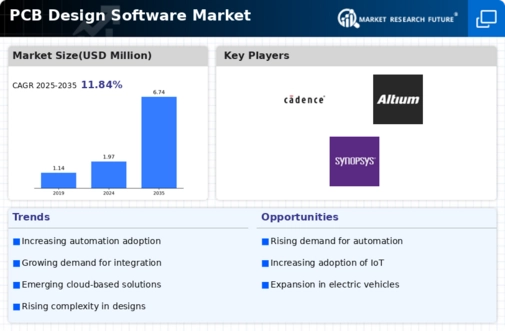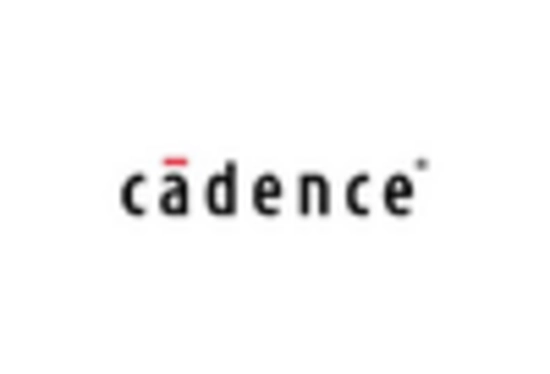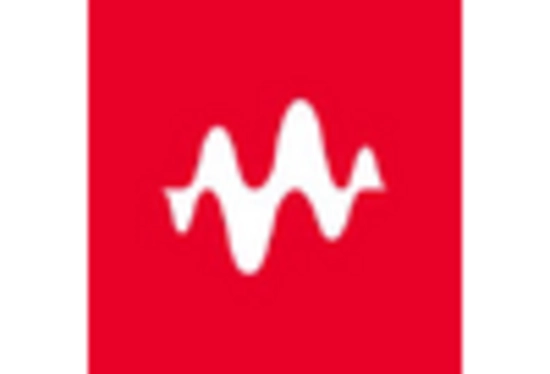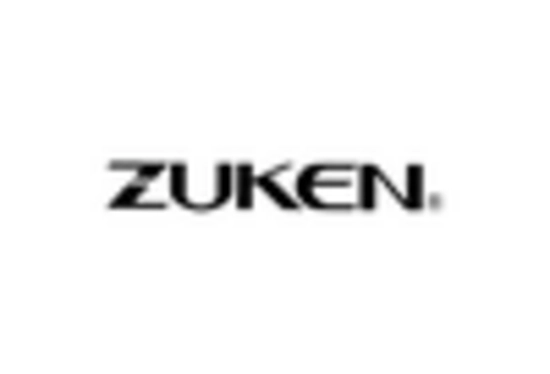-
EXECUTIVE SUMMARY 17
-
MARKET ATTRACTIVENESS ANALYSIS 19
- GLOBAL PCB DESIGN SOFTWARE MARKET, BY COMPONENT 20
- GLOBAL PCB DESIGN SOFTWARE MARKET, BY DESIGN COMPLEXITY 21
- GLOBAL PCB DESIGN SOFTWARE MARKET, BY TYPE 22
- GLOBAL PCB DESIGN SOFTWARE MARKET, BY DEPLOYMENT TYPE 23
- GLOBAL PCB DESIGN SOFTWARE MARKET, BY INDUSTRY 24
- GLOBAL PCB DESIGN SOFTWARE MARKET, BY REGION 25
-
MARKET INTRODUCTION 26
-
DEFINITION 26
-
SCOPE OF THE STUDY 26
-
MARKET STRUCTURE 27
-
RESEARCH METHODOLOGY 28
-
RESEARCH PROCESS 28
-
PRIMARY RESEARCH 29
-
SECONDARY RESEARCH 30
-
MARKET SIZE ESTIMATION 30
-
TOP DOWN & BOTTOM-UP APPROACH 31
-
FORECAST MODEL 32
-
LIST OF ASSUMPTIONS 33
-
MARKET DYNAMICS 34
-
DRIVERS 34
- RISE IN NEED TO REDUCE TIME AND ELIMINATE THE ISSUES FACED DURING PRODUCT DEVELOPMENT 34
- EXTENSIVE APPLICATION OF PCBS IN VARIOUS INDUSTRIES 35
- DRIVER IMPACT ANALYSIS 36
-
RESTRAINTS 36
- RAPID INTRODUCTION OF NEW TECHNOLOGIES 36
- RESTRAINT IMPACT ANALYSIS 37
-
OPPORTUNITIES 37
- INCREASING DEMAND FOR ADOPTION OF NEW TECHNOLOGIES 37
-
CLIENT REQUIREMENTS 38
- PCB EMI ANALYSIS 38
- PCB SIGNAL INTEGRITY (SI) ANALYSIS 40
- PCB THERMAL ANALYSIS 43
- CUSTOMER CHALLENGES IN THE PCB SOFTWARE MARKET 44
- UNMET CUSTOMER SOLUTION NEEDS IN THE PCB SOFTWARE MARKET 46
- SEGMENT OR AREAS THAT ARE OVER-SERVED AND DIFFICULT TO PENETRATE AND MARKETS THAT ARE UNDERSERVED 46
-
MARKET FACTOR ANALYSIS 48
-
SUPPLY CHAIN ANALYSIS 48
- RESEARCH AND DEVELOPMENT 49
- ELECTRONICS MANUFACTURING SERVICES 49
- END PRODUCT ASSEMBLY 49
- SERVICES 49
-
PORTER’S FIVE FORCES MODEL 50
- THREAT OF NEW ENTRANTS 50
- BARGAINING POWER OF SUPPLIERS 51
- THREAT OF SUBSTITUTES 51
- BARGAINING POWER OF BUYERS 51
- INTENSITY OF RIVALRY 51
-
IMPACT OF COVID-19 ON GLOBAL PCB DESIGN SOFTWARE MARKET 52
-
GLOBAL PCB DESIGN SOFTWARE MARKET, BY COMPONENT 53
-
OVERVIEW 53
- GLOBAL PCB DESIGN SOFTWARE MARKET ESTIMATES & FORECAST, BY COMPONENT, 2019–2032 54
-
SOFTWARE/TOOLS 55
- PCB CAM 55
- PCB SPICE 55
- CABLE/WIRE HARNESS 55
- PCB ANALYSIS TOOLS 55
- PCB AI 56
- SOFTWARE/TOOLS: MARKET ESTIMATES & FORECAST, BY REGION, 2019–2032 56
-
SERVICES 57
- SERVICES: MARKET ESTIMATES & FORECAST, BY REGION, 2019–2032 57
-
GLOBAL PCB DESIGN SOFTWARE MARKET, BY DESIGN COMPLEXITY 58
-
OVERVIEW 58
- GLOBAL PCB DESIGN SOFTWARE MARKET ESTIMATES & FORECAST, BY DESIGN COMPLEXITY, 2019–2032 59
-
LOW-END DESIGN 60
- LOW-END DESIGN: MARKET ESTIMATES & FORECAST, BY REGION, 2019–2032 60
-
MEDIUM-END DESIGN 61
- MEDIUM-END DESIGN: MARKET ESTIMATES & FORECAST, BY REGION, 2019–2032 61
-
-
HIGH-END DESIGN 62
- HIGH -END DESIGN: MARKET ESTIMATES & FORECAST, BY REGION, 2019–2032 62
-
GLOBAL PCB DESIGN SOFTWARE MARKET, BY TYPE 63
-
OVERVIEW 63
- GLOBAL PCB DESIGN SOFTWARE MARKET ESTIMATES & FORECAST, BY TYPE, 2019–2032 64
-
PCB LAYOUT 65
- PCB LAYOUT: MARKET ESTIMATES & FORECAST, BY REGION, 2019–2032 65
-
SCHEMATIC CAPTURE 66
- SCHEMATIC CAPTURE: MARKET ESTIMATES & FORECAST, BY REGION, 2019–2032 66
-
GLOBAL PCB DESIGN SOFTWARE MARKET, BY DEPLOYMENT TYPE 67
-
OVERVIEW 67
- GLOBAL PCB DESIGN SOFTWARE MARKET ESTIMATES & FORECAST, BY DEPLOYMENT TYPE, 2019–2032 68
-
CLOUD 69
- CLOUD: MARKET ESTIMATES & FORECAST, BY REGION, 2019–2032 69
-
ON-PREMISE 70
- ON-PREMISE: MARKET ESTIMATES & FORECAST, BY REGION, 2019–2032 70
-
GLOBAL PCB DESIGN SOFTWARE MARKET, BY INDUSTRY 71
-
OVERVIEW 71
- GLOBAL PCB DESIGN SOFTWARE MARKET ESTIMATES & FORECAST, BY INDUSTRY, 2019–2032 72
-
TRANSPORTATION 73
- TRANSPORTATION: MARKET ESTIMATES & FORECAST, BY REGION, 2019–2032 73
-
CONSUMER ELECTRONICS 74
- CONSUMER ELECTRONICS: MARKET ESTIMATES & FORECAST, BY REGION, 2019–2032 74
-
TELECOMMUNICATIONS 75
- TELECOMMUNICATIONS: MARKET ESTIMATES & FORECAST, BY REGION, 2019–2032 75
-
SEMICONDUCTORS 76
- SEMICONDUCTORS: MARKET ESTIMATES & FORECAST, BY REGION, 2019–2032 76
-
AEROSPACE & DEFENSE 77
- AEROSPACE & DEFENSE: MARKET ESTIMATES & FORECAST, BY REGION, 2019–2032 77
-
HEALTHCARE 78
- HEALTHCARE: MARKET ESTIMATES & FORECAST, BY REGION, 2019–2032 78
-
INDUSTRIAL AUTOMATION & CONTROL 79
- INDUSTRIAL AUTOMATION & CONTROL: MARKET ESTIMATES & FORECAST, BY REGION, 2019–2032 79
-
EDUCATION & RESEARCH 80
- EDUCATION & RESEARCH: MARKET ESTIMATES & FORECAST, BY REGION, 2019–2032 80
-
-
GLOBAL PCB DESIGN SOFTWARE, BY REGION 81
-
OVERVIEW 81
- GLOBAL PCB DESIGN SOFTWARE MARKET ESTIMATES & FORECAST, BY REGION, 2019–2032 82
-
NORTH AMERICA 83
- NORTH AMERICA PCB DESIGN SOFTWARE MARKET ESTIMATES & FORECAST, BY COUNTRY, 2019–2032 84
- US 86
- CANADA 88
- MEXICO 90
-
EUROPE 93
- EUROPE PCB DESIGN SOFTWARE MARKET ESTIMATES & FORECAST, BY COUNTRY, 2019–2032 94
- GERMANY 96
- UK 98
- FRANCE 100
- ITALY 102
- REST OF EUROPE 104
-
ASIA-PACIFIC 107
- ASIA-PACIFIC PCB DESIGN SOFTWARE MARKET ESTIMATES & FORECAST, BY COUNTRY, 2019–2032 108
- CHINA 110
- INDIA 112
- JAPAN 114
- SOUTH KOREA 116
- REST OF ASIA-PACIFIC 118
-
MIDDLE EAST & AFRICA 121
-
SOUTH AMERICA 124
-
COMPETITIVE LANDSCAPE 127
-
COMPETITIVE OVERVIEW 127
-
GLOBAL PCB DESIGN SOFTWARE MARKET: COMPANY SHARE ANALYSIS 127
-
MAJOR GROWTH STRATEGY IN THE GLOBAL PCB DESIGN SOFTWARE MARKET 128
-
COMPETITIVE BENCHMARKING 129
-
COMPANY PROFILES 130
-
MENTOR GRAPHICS 130
- COMPANY OVERVIEW 130
- FINANCIAL OVERVIEW 130
- PRODUCTS OFFERED 131
- KEY DEVELOPMENTS 131
- KEY STRATEGIES 131
-
-
CADENCE DESIGN SYSTEMS 132
- COMPANY OVERVIEW 132
- FINANCIAL OVERVIEW 133
- PRODUCTS OFFERED 134
- KEY DEVELOPMENTS 134
- SWOT ANALYSIS 135
- KEY STRATEGIES 135
-
ZUKEN INC 136
- COMPANY OVERVIEW 136
- FINANCIAL OVERVIEW 137
- PRODUCTS OFFERED 137
- KEY DEVELOPMENTS 138
- SWOT ANALYSIS 139
- KEY STRATEGIES 139
-
ALTIUM 140
- COMPANY OVERVIEW 140
- FINANCIAL OVERVIEW 141
- PRODUCTS OFFERED 141
- KEY DEVELOPMENTS 142
- SWOT ANALYSIS 143
- KEY STRATEGIES 143
-
CADSOFT (AUTODESK INC.) 144
- COMPANY OVERVIEW 144
- FINANCIAL OVERVIEW 145
- PRODUCTS OFFERED 145
- KEY DEVELOPMENTS 146
- SWOT ANALYSIS 146
- KEY STRATEGIES 146
-
NOVARM 147
- COMPANY OVERVIEW 147
- FINANCIAL OVERVIEW 147
- PRODUCTS OFFERED 147
- KEY DEVELOPMENTS 147
- KEY STRATEGIES 147
-
SHANGHAI TSINGYUE 148
- COMPANY OVERVIEW 148
- FINANCIAL OVERVIEW 148
- PRODUCTS OFFERED 148
- KEY DEVELOPMENTS 149
- KEY STRATEGIES 149
-
FORTE DESIGN SYSTEMS INC. 150
- COMPANY OVERVIEW 150
- FINANCIAL OVERVIEW 150
- PRODUCTS OFFERED 150
- KEY DEVELOPMENTS 150
- KEY STRATEGIES 150
-
SYNOPSYS 151
- COMPANY OVERVIEW 151
- FINANCIAL OVERVIEW 152
- PRODUCTS OFFERED 152
- KEY DEVELOPMENTS 153
- SWOT ANALYSIS 153
- KEY STRATEGIES 154
-
SOLIDWORKS 155
- COMPANY OVERVIEW 155
- FINANCIAL OVERVIEW 155
- PRODUCTS OFFERED 156
- KEY DEVELOPMENTS 156
- SWOT ANALYSIS 156
- KEY STRATEGIES 156
-
WESTDEV LTD. 157
- COMPANY OVERVIEW 157
- FINANCIAL OVERVIEW 157
- PRODUCTS OFFERED 157
- KEY DEVELOPMENTS 158
- KEY STRATEGIES 158
-
ANSYS 159
- COMPANY OVERVIEW 159
- FINANCIAL OVERVIEW 160
- PRODUCTS OFFERED 161
- KEY DEVELOPMENTS 161
- SWOT ANALYSIS 162
- KEY STRATEGIES 162
-
-
ANALYST VIEW 163
-
APPENDIX 170
-
REFERENCES 170
-
RELATED REPORTS 170
-
-
LIST OF TABLES
-
LIST OF ASSUMPTIONS 33
-
GLOBAL PCB DESIGN SOFTWARE MARKET ESTIMATES & FORECAST, BY COMPONENT, 2019–2032 (USD MILLION) 54
-
SOFTWARE/TOOLS: MARKET ESTIMATES & FORECAST, BY REGION, 2019–2032 (USD MILLION) 56
-
SERVICES: MARKET ESTIMATES & FORECAST, BY REGION, 2019–2032 (USD MILLION) 57
-
GLOBAL PCB DESIGN SOFTWARE MARKET ESTIMATES & FORECAST, BY DESIGN COMPLEXITY, 2019–2032 (USD MILLION) 59
-
LOW-END DESIGN: MARKET ESTIMATES & FORECAST, BY REGION, 2019–2032 (USD MILLION) 60
-
MEDIUM-END DESIGN: MARKET ESTIMATES & FORECAST, BY REGION, 2019–2032 (USD MILLION) 61
-
HIGH -END DESIGN: MARKET ESTIMATES & FORECAST, BY REGION, 2019–2032 (USD MILLION) 62
-
GLOBAL PCB DESIGN SOFTWARE MARKET ESTIMATES & FORECAST, BY TYPE, 2019–2032 (USD MILLION) 64
-
PCB LAYOUT: MARKET ESTIMATES & FORECAST, BY REGION, 2019–2032 (USD MILLION) 65
-
SCHEMATIC CAPTURE: MARKET ESTIMATES & FORECAST, BY REGION, 2019–2032 (USD MILLION) 66
-
GLOBAL PCB DESIGN SOFTWARE MARKET ESTIMATES & FORECAST, BY DEPLOYMENT TYPE, 2019–2032 (USD MILLION) 68
-
CLOUD: MARKET ESTIMATES & FORECAST, BY REGION, 2019–2032 (USD MILLION) 69
-
ON-PREMISE: MARKET ESTIMATES & FORECAST, BY REGION, 2019–2032 (USD MILLION) 70
-
GLOBAL PCB DESIGN SOFTWARE MARKET ESTIMATES & FORECAST, BY INDUSTRY, 2019–2032 (USD MILLION) 72
-
TRANSPORTATION: MARKET ESTIMATES & FORECAST, BY REGION, 2019–2032 (USD MILLION) 73
-
CONSUMER ELECTRONICS: MARKET ESTIMATES & FORECAST, BY REGION, 2019–2032 (USD MILLION) 74
-
TELECOMMUNICATIONS: MARKET ESTIMATES & FORECAST, BY REGION, 2019–2032 (USD MILLION) 75
-
SEMICONDUCTORS: MARKET ESTIMATES & FORECAST, BY REGION, 2019–2032 (USD MILLION) 76
-
AEROSPACE & DEFENSE: MARKET ESTIMATES & FORECAST, BY REGION, 2019–2032 (USD MILLION) 77
-
HEALTHCARE: MARKET ESTIMATES & FORECAST, BY REGION, 2019–2032 (USD MILLION) 78
-
INDUSTRIAL AUTOMATION & CONTROL: MARKET ESTIMATES & FORECAST, BY REGION, 2019–2032 (USD MILLION) 79
-
EDUCATION & RESEARCH: MARKET ESTIMATES & FORECAST, BY REGION, 2019–2032 (USD MILLION) 80
-
GLOBAL PCB DESIGN SOFTWARE MARKET ESTIMATES & FORECAST, BY REGION, 2019–2032 (USD MILLION) 82
-
NORTH AMERICA: MARKET ESTIMATES & FORECAST, BY COUNTRY, 2019–2032 (USD MILLION) 84
-
NORTH AMERICA: MARKET ESTIMATES, BY COMPONENT, 2019–2032 (USD MILLION) 84
-
NORTH AMERICA: MARKET ESTIMATES, BY DESIGN COMPLEXITY, 2019–2032 (USD MILLION) 85
-
NORTH AMERICA: MARKET ESTIMATES, BY TYPE, 2019–2032 (USD MILLION) 85
-
NORTH AMERICA: MARKET ESTIMATES, BY DEPLOYMENT TYPE, 2019–2032 (USD MILLION) 85
-
NORTH AMERICA: MARKET ESTIMATES, BY INDUSTRY, 2019–2032 (USD MILLION) 86
-
US: MARKET ESTIMATES, BY COMPONENT, 2019–2032 (USD MILLION) 86
-
US: MARKET ESTIMATES, BY DESIGN COMPLEXITY, 2019–2032 (USD MILLION) 87
-
US: MARKET ESTIMATES, BY TYPE, 2019–2032 (USD MILLION) 87
-
US: MARKET ESTIMATES, BY DEPLOYMENT TYPE, 2019–2032 (USD MILLION) 87
-
US: MARKET ESTIMATES, BY INDUSTRY, 2019–2032 (USD MILLION) 88
-
CANADA: MARKET ESTIMATES, BY COMPONENT, 2019–2032 (USD MILLION) 88
-
CANADA: MARKET ESTIMATES, BY DESIGN COMPLEXITY, 2019–2032 (USD MILLION) 89
-
CANADA: MARKET ESTIMATES, BY TYPE, 2019–2032 (USD MILLION) 89
-
CANADA: MARKET ESTIMATES, BY DEPLOYMENT TYPE, 2019–2032 (USD MILLION) 89
-
CANADA: MARKET ESTIMATES, BY INDUSTRY, 2019–2032 (USD MILLION) 90
-
MEXICO: MARKET ESTIMATES, BY COMPONENT, 2019–2032 (USD MILLION) 90
-
MEXICO: MARKET ESTIMATES, BY DESIGN COMPLEXITY, 2019–2032 (USD MILLION) 91
-
MEXICO: MARKET ESTIMATES, BY TYPE, 2019–2032 (USD MILLION) 91
-
MEXICO: MARKET ESTIMATES, BY DEPLOYMENT TYPE, 2019–2032 (USD MILLION) 91
-
MEXICO: MARKET ESTIMATES, BY INDUSTRY, 2019–2032 (USD MILLION) 92
-
EUROPE: MARKET ESTIMATES & FORECAST, BY COUNTRY, 2019–2032 (USD MILLION) 94
-
EUROPE: MARKET ESTIMATES, BY COMPONENT, 2019–2032 (USD MILLION) 94
-
EUROPE: MARKET ESTIMATES, BY DESIGN COMPLEXITY, 2019–2032 (USD MILLION) 95
-
EUROPE: MARKET ESTIMATES, BY TYPE, 2019–2032 (USD MILLION) 95
-
EUROPE: MARKET ESTIMATES, BY DEPLOYMENT TYPE, 2019–2032 (USD MILLION) 95
-
EUROPE: MARKET ESTIMATES, BY INDUSTRY, 2019–2032 (USD MILLION) 96
-
GERMANY: MARKET ESTIMATES, BY COMPONENT, 2019–2032 (USD MILLION) 96
-
GERMANY: MARKET ESTIMATES, BY DESIGN COMPLEXITY, 2019–2032 (USD MILLION) 97
-
GERMANY: MARKET ESTIMATES, BY TYPE, 2019–2032 (USD MILLION) 97
-
GERMANY: MARKET ESTIMATES, BY DEPLOYMENT TYPE, 2019–2032 (USD MILLION) 97
-
GERMANY: MARKET ESTIMATES, BY INDUSTRY, 2019–2032 (USD MILLION) 98
-
UK: MARKET ESTIMATES, BY COMPONENT, 2019–2032 (USD MILLION) 98
-
UK: MARKET ESTIMATES, BY DESIGN COMPLEXITY, 2019–2032 (USD MILLION) 99
-
UK: MARKET ESTIMATES, BY TYPE, 2019–2032 (USD MILLION) 99
-
UK: MARKET ESTIMATES, BY DEPLOYMENT TYPE, 2019–2032 (USD MILLION) 99
-
UK: MARKET ESTIMATES, BY INDUSTRY, 2019–2032 (USD MILLION) 100
-
FRANCE: MARKET ESTIMATES, BY COMPONENT, 2019–2032 (USD MILLION) 100
-
FRANCE: MARKET ESTIMATES, BY DESIGN COMPLEXITY, 2019–2032 (USD MILLION) 101
-
FRANCE: MARKET ESTIMATES, BY TYPE, 2019–2032 (USD MILLION) 101
-
FRANCE: MARKET ESTIMATES, BY DEPLOYMENT TYPE, 2019–2032 (USD MILLION) 101
-
FRANCE: MARKET ESTIMATES, BY INDUSTRY, 2019–2032 (USD MILLION) 102
-
ITALY: MARKET ESTIMATES, BY COMPONENT, 2019–2032 (USD MILLION) 102
-
ITALY: MARKET ESTIMATES, BY DESIGN COMPLEXITY, 2019–2032 (USD MILLION) 103
-
ITALY: MARKET ESTIMATES, BY TYPE, 2019–2032 (USD MILLION) 103
-
ITALY: MARKET ESTIMATES, BY DEPLOYMENT TYPE, 2019–2032 (USD MILLION) 103
-
ITALY: MARKET ESTIMATES, BY INDUSTRY, 2019–2032 (USD MILLION) 104
-
REST OF EUROPE: MARKET ESTIMATES, BY COMPONENT, 2019–2032 (USD MILLION) 104
-
REST OF EUROPE: MARKET ESTIMATES, BY DESIGN COMPLEXITY, 2019–2032 (USD MILLION) 105
-
REST OF EUROPE: MARKET ESTIMATES, BY TYPE, 2019–2032 (USD MILLION) 105
-
REST OF EUROPE: MARKET ESTIMATES, BY DEPLOYMENT TYPE, 2019–2032 (USD MILLION) 105
-
REST OF EUROPE: MARKET ESTIMATES, BY INDUSTRY, 2019–2032 (USD MILLION) 106
-
ASIA-PACIFIC: MARKET ESTIMATES & FORECAST, BY COUNTRY, 2019–2032 (USD MILLION) 108
-
ASIA-PACIFIC: MARKET ESTIMATES, BY COMPONENT, 2019–2032 (USD MILLION) 108
-
ASIA-PACIFIC: MARKET ESTIMATES, BY DESIGN COMPLEXITY, 2019–2032 (USD MILLION) 109
-
ASIA-PACIFIC: MARKET ESTIMATES, BY TYPE, 2019–2032 (USD MILLION) 109
-
ASIA-PACIFIC: MARKET ESTIMATES, BY DEPLOYMENT TYPE, 2019–2032 (USD MILLION) 109
-
ASIA-PACIFIC: MARKET ESTIMATES, BY INDUSTRY, 2019–2032 (USD MILLION) 110
-
CHINA: MARKET ESTIMATES, BY COMPONENT, 2019–2032 (USD MILLION) 110
-
CHINA: MARKET ESTIMATES, BY DESIGN COMPLEXITY, 2019–2032 (USD MILLION) 111
-
CHINA: MARKET ESTIMATES, BY TYPE, 2019–2032 (USD MILLION) 111
-
CHINA: MARKET ESTIMATES, BY DEPLOYMENT TYPE, 2019–2032 (USD MILLION) 111
-
CHINA: MARKET ESTIMATES, BY INDUSTRY, 2019–2032 (USD MILLION) 112
-
INDIA: MARKET ESTIMATES, BY COMPONENT, 2019–2032 (USD MILLION) 112
-
INDIA: MARKET ESTIMATES, BY DESIGN COMPLEXITY, 2019–2032 (USD MILLION) 113
-
INDIA: MARKET ESTIMATES, BY TYPE, 2019–2032 (USD MILLION) 113
-
INDIA: MARKET ESTIMATES, BY DEPLOYMENT TYPE, 2019–2032 (USD MILLION) 113
-
INDIA: MARKET ESTIMATES, BY INDUSTRY, 2019–2032 (USD MILLION) 114
-
JAPAN: MARKET ESTIMATES, BY COMPONENT, 2019–2032 (USD MILLION) 114
-
JAPAN: MARKET ESTIMATES, BY DESIGN COMPLEXITY, 2019–2032 (USD MILLION) 115
-
JAPAN: MARKET ESTIMATES, BY TYPE, 2019–2032 (USD MILLION) 115
-
JAPAN: MARKET ESTIMATES, BY DEPLOYMENT TYPE, 2019–2032 (USD MILLION) 115
-
JAPAN: MARKET ESTIMATES, BY INDUSTRY, 2019–2032 (USD MILLION) 116
-
SOUTH KOREA: MARKET ESTIMATES, BY COMPONENT, 2019–2032 (USD MILLION) 116
-
SOUTH KOREA: MARKET ESTIMATES, BY DESIGN COMPLEXITY, 2019–2032 (USD MILLION) 117
-
SOUTH KOREA: MARKET ESTIMATES, BY TYPE, 2019–2032 (USD MILLION) 117
-
SOUTH KOREA: MARKET ESTIMATES, BY DEPLOYMENT TYPE, 2019–2032 (USD MILLION) 117
-
SOUTH KOREA: MARKET ESTIMATES, BY INDUSTRY, 2019–2032 (USD MILLION) 118
-
REST OF ASIA-PACIFIC: MARKET ESTIMATES, BY COMPONENT, 2019–2032 (USD MILLION) 118
-
REST OF ASIA-PACIFIC: MARKET ESTIMATES, BY DESIGN COMPLEXITY, 2019–2032 (USD MILLION) 119
-
REST OF ASIA-PACIFIC: MARKET ESTIMATES, BY TYPE, 2019–2032 (USD MILLION) 119
-
REST OF ASIA-PACIFIC: MARKET ESTIMATES, BY DEPLOYMENT TYPE, 2019–2032 (USD MILLION) 119
-
REST OF ASIA-PACIFIC: MARKET ESTIMATES, BY INDUSTRY, 2019–2032 (USD MILLION) 120
-
MIDDLE EAST & AFRICA: MARKET ESTIMATES, BY COMPONENT, 2019–2032 (USD MILLION) 121
-
MIDDLE EAST & AFRICA: MARKET ESTIMATES, BY DESIGN COMPLEXITY, 2019–2032 (USD MILLION) 121
-
MIDDLE EAST & AFRICA: MARKET ESTIMATES, BY TYPE, 2019–2032 (USD MILLION) 122
-
MIDDLE EAST & AFRICA: MARKET ESTIMATES, BY DEPLOYMENT TYPE, 2019–2032 (USD MILLION) 122
-
MIDDLE EAST & AFRICA: MARKET ESTIMATES, BY INDUSTRY, 2019–2032 (USD MILLION) 123
-
SOUTH AMERICA: MARKET ESTIMATES, BY COMPONENT, 2019–2032 (USD MILLION) 124
-
SOUTH AMERICA: MARKET ESTIMATES, BY DESIGN COMPLEXITY, 2019–2032 (USD MILLION) 124
-
SOUTH AMERICA: MARKET ESTIMATES, BY TYPE, 2019–2032 (USD MILLION) 125
-
SOUTH AMERICA: MARKET ESTIMATES, BY DEPLOYMENT TYPE, 2019–2032 (USD MILLION) 125
-
SOUTH AMERICA: MARKET ESTIMATES, BY INDUSTRY, 2019–2032 (USD MILLION) 126
-
MENTOR GRAPHICS: PRODUCTS OFFERED 131
-
MENTOR GRAPHICS: KEY DEVELOPMENTS 131
-
CADENCE DESIGN SYSTEMS: PRODUCTS OFFERED 134
-
CADENCE DESIGN SYSTEMS: KEY DEVELOPMENTS 134
-
ZUKEN INC: PRODUCTS OFFERED 137
-
ZUKEN INC: KEY DEVELOPMENTS 138
-
ALTIUM: PRODUCTS OFFERED 141
-
ALTIUM: KEY DEVELOPMENTS 142
-
CADSOFT (AUTODESK INC.): PRODUCTS OFFERED 145
-
NOVARM: PRODUCTS OFFERED 147
-
SHANGHAI TSINGYUE: PRODUCTS OFFERED 148
-
FORTE DESIGN SYSTEMS INC: PRODUCTS OFFERED 150
-
SYNOPSYS: PRODUCTS OFFERED 152
-
SYNOPSYS: KEY DEVELOPMENTS 153
-
SOLIDWORKS: PRODUCTS OFFERED 156
-
WESTDEV LTD: PRODUCTS OFFERED 157
-
WESTDEV LTD: KEY DEVELOPMENTS 158
-
ANSYS, INC: PRODUCTS OFFERED 161
-
ANSYS, INC: KEY DEVELOPMENTS 161
-
-
LIST OF FIGURES
-
MARKET SYNOPSIS 18
-
MARKET ATTRACTIVENESS ANALYSIS: GLOBAL PCB DESIGN SOFTWARE MARKET, 2022 19
-
GLOBAL PCB DESIGN SOFTWARE MARKET ANALYSIS, BY COMPONENT, 2022 20
-
GLOBAL PCB DESIGN SOFTWARE MARKET ANALYSIS, BY DESIGN COMPLEXITY, 2022 21
-
GLOBAL PCB DESIGN SOFTWARE MARKET ANALYSIS, BY TYPE, 2022 22
-
GLOBAL PCB DESIGN SOFTWARE MARKET ANALYSIS, BY DEPLOYMENT TYPE, 2022 23
-
GLOBAL PCB DESIGN SOFTWARE MARKET ANALYSIS, BY INDUSTRY, 2022 24
-
GLOBAL PCB DESIGN SOFTWARE MARKET ANALYSIS, BY REGION, 2022 25
-
GLOBAL PCB DESIGN SOFTWARE MARKET: STRUCTURE 27
-
RESEARCH PROCESS OF MRFR 28
-
DROC ANALYSIS OF GLOBAL PCB DESIGN SOFTWARE MARKET 34
-
DRIVER IMPACT ANALYSIS 36
-
RESTRAINT IMPACT ANALYSIS 37
-
SUPPLY CHAIN: GLOBAL PCB DESIGN SOFTWARE MARKET 48
-
GLOBAL PCB DESIGN SOFTWARE MARKET, BY COMPONENT, 2022 (% SHARE) 53
-
GLOBAL PCB DESIGN SOFTWARE MARKET, BY COMPONENT, 2019–2032 (USD MILLION) 54
-
GLOBAL PCB DESIGN SOFTWARE MARKET, BY DESIGN COMPLEXITY, 2022 (% SHARE) 58
-
GLOBAL PCB DESIGN SOFTWARE MARKET, BY DESIGN COMPLEXITY, 2019–2032 (USD MILLION) 59
-
GLOBAL PCB DESIGN SOFTWARE MARKET, BY TYPE, 2022 (% SHARE) 63
-
GLOBAL PCB DESIGN SOFTWARE MARKET, BY TYPE, 2019–2032 (USD MILLION) 64
-
GLOBAL PCB DESIGN SOFTWARE MARKET, BY DEPLOYMENT TYPE, 2022 (% SHARE) 67
-
GLOBAL PCB DESIGN SOFTWARE MARKET, BY DEPLOYMENT TYPE, 2019–2032 (USD MILLION) 68
-
GLOBAL PCB DESIGN SOFTWARE MARKET, BY INDUSTRY, 2022 (% SHARE) 71
-
GLOBAL PCB DESIGN SOFTWARE MARKET, BY INDUSTRY, 2019–2032 (USD MILLION) 72
-
GLOBAL PCB DESIGN SOFTWARE MARKET, BY REGION, 2022 (% SHARE) 81
-
GLOBAL PCB DESIGN SOFTWARE MARKET, BY REGION, 2019–2032 (USD MILLION) 82
-
NORTH AMERICA: PCB DESIGN SOFTWARE MARKET SHARE, BY COUNTRY, 2022 (% SHARE) 83
-
EUROPE: PCB DESIGN SOFTWARE MARKET SHARE, BY COUNTRY, 2022 (% SHARE) 93
-
ASIA-PACIFIC: PCB DESIGN SOFTWARE MARKET SHARE, BY COUNTRY, 2022 (% SHARE) 107
-
GLOBAL PCB DESIGN SOFTWARE MAJOR PLAYERS MARKET SHARE ANALYSIS, 2022 (% SHARE) 127
-
CADENCE DESIGN SYSTEMS: FINANCIAL OVERVIEW SNAPSHOT 133
-
CADENCE DESIGN SYSTEMS: SWOT ANALYSIS 135
-
ZUKEN INC: FINANCIAL OVERVIEW SNAPSHOT 137
-
ZUKEN INC: SWOT ANALYSIS 139
-
ALTIUM: FINANCIAL OVERVIEW SNAPSHOT 141
-
ALTIUM: SWOT ANALYSIS 143
-
AUTODESK INC.: FINANCIAL OVERVIEW SNAPSHOT 145
-
CADSOFT (AUTODESK INC.): SWOT ANALYSIS 146
-
SYNOPSYS: FINANCIAL OVERVIEW SNAPSHOT 152
-
SYNOPSYS: SWOT ANALYSIS 153
-
DASSAULT SYSTEMES: FINANCIAL OVERVIEW SNAPSHOT 155
-
DASSAULT SYSTEMES: SWOT ANALYSIS 156
-
ANSYS, INC: FINANCIAL OVERVIEW SNAPSHOT 160
-
ANSYS, INC: SWOT ANALYSIS 162
-
GLOBAL PCB DESIGN SOFTWARE MARKET, BY REGION, 2022 (% SHARE) 165"









Leave a Comment